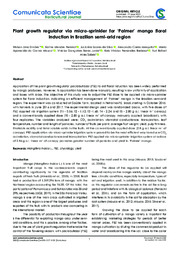Plant growth regulator via micro-sprinkler for Palmer mango floral induction in Brazilian semi-arid region.
Plant growth regulator via micro-sprinkler for Palmer mango floral induction in Brazilian semi-arid region.
Autoria: SIMOES, W. L.; PEREIRA, K. M.; SILVA, J. S. da; MESQUITA, A. C.; MOUCO, M. A. do C.; TORRES JÚNIOR, V. G.; BARBOSA, K. V. F.; SOBRAL, Y. R. A.
Resumo: Application of the plant growth regulator paclobutrazol (PBZ) to aid floral induction has been widely performed by mango producers. However, its application has been done manually, resulting in low uniformity of application and losses with labor. The objective of this study was to adjust the PBZ dose to be applied via micro-sprinkler system for floral induction, indicating an efficient management of ?Palmer? mango in the Brazilian semi-arid region. The experiment was conducted at Saúde Farm, located in Petrolina-PE, Brazil, starting in October 2015, with harvests in June 2016 and 2017. The experimental design used was randomized blocks, with five doses of PBZ, applied via irrigation system (T1 - 0.56; T2 - 1.12; T3 -1.68; T4 - 2.24; and T5 - 2.80 g a.i. linear m-1 canopy) and a conventionally applied dose (T0 - 2.80 g a.i. linear m-1 of canopy, manually applied broadcast), with four replicates. The variables analyzed were: CO2 assimilation, stomatal conductance, transpiration, leaf temperature, number and length of panicles, number of fruits per plant, average fruit weight, yield, pulp firmness, titratable acidity and total soluble solids in the fruits. At the conventionally applied dose (2.8 g a.i. linear m-1 of canopy), PBZ application via micro-sprinkler irrigation system proved to be the most efficient way to reduce CO2 assimilation, stomatal conductance and transpiration. PBZ applied via micro-sprinkler irrigation system at a dose of 0.56 g a.i. linear m-1 of canopy promotes greater number of panicles and yield in ?Palmer? mango.
Ano de publicação: 2023
Tipo de publicação: Artigo de periódico
Unidade: Embrapa Semiárido
Observações
1 - Por padrão são exibidas publicações dos últimos 20 anos. Para encontrar publicações mais antigas, configure o filtro ano de publicação, colocando o ano a partir do qual você deseja encontrar publicações. O filtro está na coluna da esquerda na busca acima.
2 - Para ler algumas publicações da Embrapa (apenas as que estão em formato ePub), é necessário ter, no celular ou computador, um desses softwares gratuitos. Sistemas Android: Google Play Livros; IOS: iBooks; Windows e Linux: software Calibre.
Acesse outras publicações
Acesse a Base de Dados da Pesquisa Agropecuária (BDPA) para consultar o acervo completo das bibliotecas da Embrapa.

